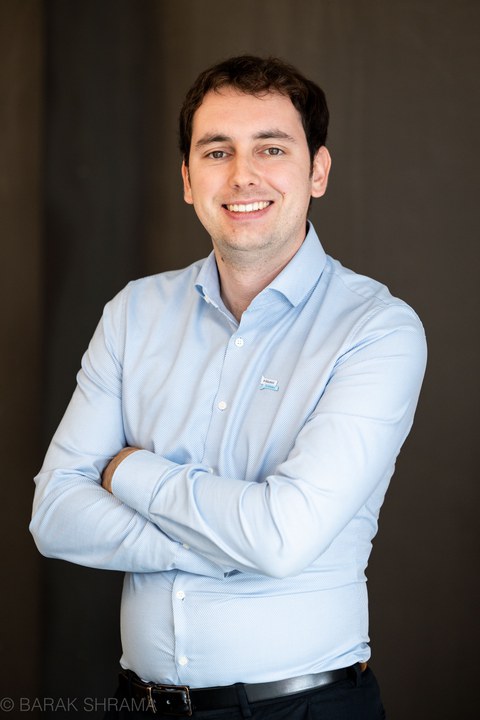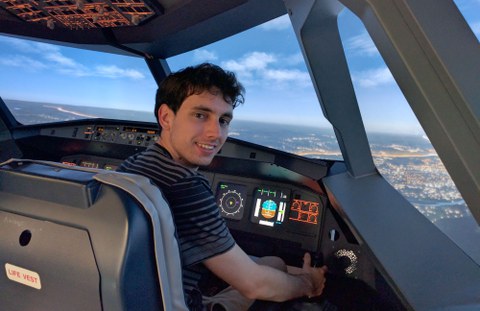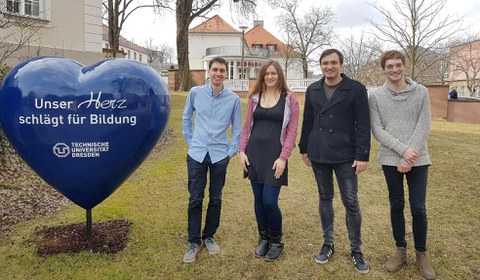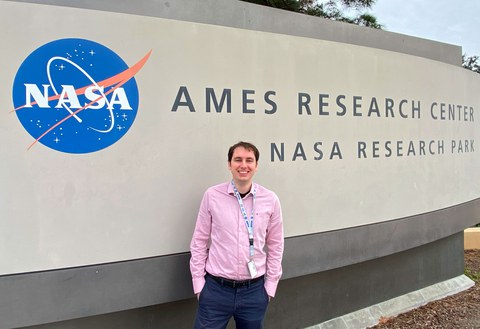Fascinated by flying
(interviewed in 2024)
Dagmar Möbius
Kevin-Christian Garzon Galindo was a two-month-old baby when he flew to Colombia for the first time. Flights to his mother's home country were such a part of his life that there was only one profession he could imagine pursuing - that of a pilot. But that didn't work out. Born in Austria, he studied Transport Engineering at TUD and got employed by NASA. But he doesn't see himself as particularly gifted.

Kevin Garzon-Galindo
"I even had to repeat a year of school because of math," laughs the 30-year-old. He uses this anecdote to take the wind out of the sails of anyone who thinks he was just lucky. In fact, Kevin-Christian Garzon Galindo has consistently pursued his dream of flying and has even gone the extra mile for it. The fact that his job today is different from what he had originally planned is by no means a disappointment for him. He is an enthusiastic researcher and is working on the future of aviation and aerospace.
How his career aspiration came about
"My family is far from having any connection to aviation and is not wealthy either," he says. Being born in Bregenz, "I grew up with the annual flights to Colombia and couldn't imagine a career other than becoming a Lufthansa pilot and flying a commercial aircraft. Unfortunately, the airlines' health requirements were very strict and my eyes were too bad for that." Aircraft construction as an alternative was out of the question for Kevin-Christian Garzon Galindo. It was a friend who recommended the one-of-a-kind Transport Engineering degree program at TU Dresden, with a specialization in transport systems technology and logistics and a concentration on air transport.
Excellent insight into the air transport system
After completing his alternative civilian service with the Red Cross in Austria, Kevin-Christian Garzon Galindo began his studies in Dresden in 2014. He describes the theoretical basis as really great and useful: "We got an excellent insight into the aviation system. The support was phenomenal. But we were also expected to knuckle down." Of the 140 students who started the program, half had dropped out by the fourth semester. Kevin-Christian Garzon Galindo was fascinated by the chair's simulation facilities and spent a lot of time in the flight simulator. He only realized later what practical skills he lacked. When looking for a compulsory internship in his 9th semester, which he wanted to do abroad, Professor Hartmut Fricke recommended several websites. "One of them was at NASA. I found that exciting." He applied – and was rejected after a long wait. But he asked for the reasons. When he was told that they were looking for people with more digital skills, he learned how to write code.

In the cockpit of the Airbus A320 research simulator at the Chair of Aviation Technology and Logistics
A year abroad in the Netherlands
Kevin-Christian Garzon Galindo spent a year at Delft University of Technology on an Erasmus program. This is where he acquired the knowledge in mechanical engineering that he still lacked in aerospace engineering. And in every subject, he partook in group work that was designed in such a way that you couldn't solve the tasks without programming knowledge – which in turn helped in his scientific work. In addition, individual or group work was given the same weighting as exams in relation to the final grades. This was a new experience for the aspiring aeronautical engineer. "I'm not good at written exams," he admits with a grin: "Cramming just to pass an exam is not for me." He realized that project work is much more his thing.
Many highlights during his studies
Kevin-Christian Garzon Galindo had a wealth of special experiences. His eyes light up when he talks about taking part in the Student Challenge at the 2018 ICRAT conference in Barcelona (which he won). For the challenge, Kevin-Christian Garzon Galindo was sent large amounts of data from the US Department of Transportation. The data was analyzed so quickly in the program that he had developed that he initially thought he had done something wrong. But he hadn't.
He was also enthusiastic about working on a concept for Berlin Airport operations. He worked as a student tutor and was involved in numerous committees, in the Faculty Student Council and in the Senate. Not all of his fellow students approved of his commitment to lectures in English for his degree program: "I want to improve something, and where else would that be better suited than at a University of Excellence in this kind of degree program?" he counters.

Kevin-Christian Garzon Galindo was 2016/17 a member of the TUD Senate.
Second application to NASA
Encouraged by Professor Fricke, as well as friends and family, Kevin-Christian Garzon Galindo dared to reapply to NASA. "I didn't want to be intrusive, but I then wrote about everything I had done in the meantime." He was able to reap the reward of his boldness on December 20, 2018. His current boss emailed him that he was thrilled with how much knowledge he had amassed within a year and with the fact that he had organized everything himself. Three months later, the Transport Engineering graduate received the final go-ahead to start a part-time research job at the research foundation of San Jose State University at the NASA Ames Research Center.
The topic of his diploma thesis arose from his work: Detect-and-Avoid in off-nominal Situations for Supersonic Transport Aircraft in upper Class E Airspace.

Kevin-Christian Garzon Galindo in front of the entrance to the NASA Ames Research Center
Many more challenges to overcome
Kevin-Christian Garzon Galindo has been part of the National Aeronautics and Space Administration (NASA) for more than five years now. He is conducting research on a new airspace management system in the stratosphere, at an altitude of 18 to 20 km. Non-experts can imagine the challenges as follows: "At the moment, we have a very homogeneous system. However, we increasingly have to take into account balloons, weather observation stations, airships and supersonic aircraft in air traffic. All fly in different ways. How can we integrate all of these?"
And there is another major goal. Net-zero carbon dioxide emissions from aviation by 2050. "We still have many more challenges to overcome," the research engineer says. He is so enthusiastic about his work that he now wants to do a doctorate.
Plans for the future
Kevin-Christian Garzon Galindo spoke briefly with the Rector during her visit to San Francisco. He is planning to found an alumni chapter for the San Francisco Bay Area because he knows of more than 200 TUD alumni in the region. There is already a WhatsApp group for the California network, and a regular meet up will be arrange in the future. The German Consul General and the German Science Center have pledged their support.

In conversation with TUD Rector Prof. Staudinger and Jeremiah Peterson, TUD Coordinator International Alumni Relations
The aviation enthusiast has also achieved a personal goal: He recently passed his theoretical exam in flying. So he will become a pilot after all. As a hobby.
Contact:
Kevin-Christian Garzon Galindo
Aerospace Research Engineer
